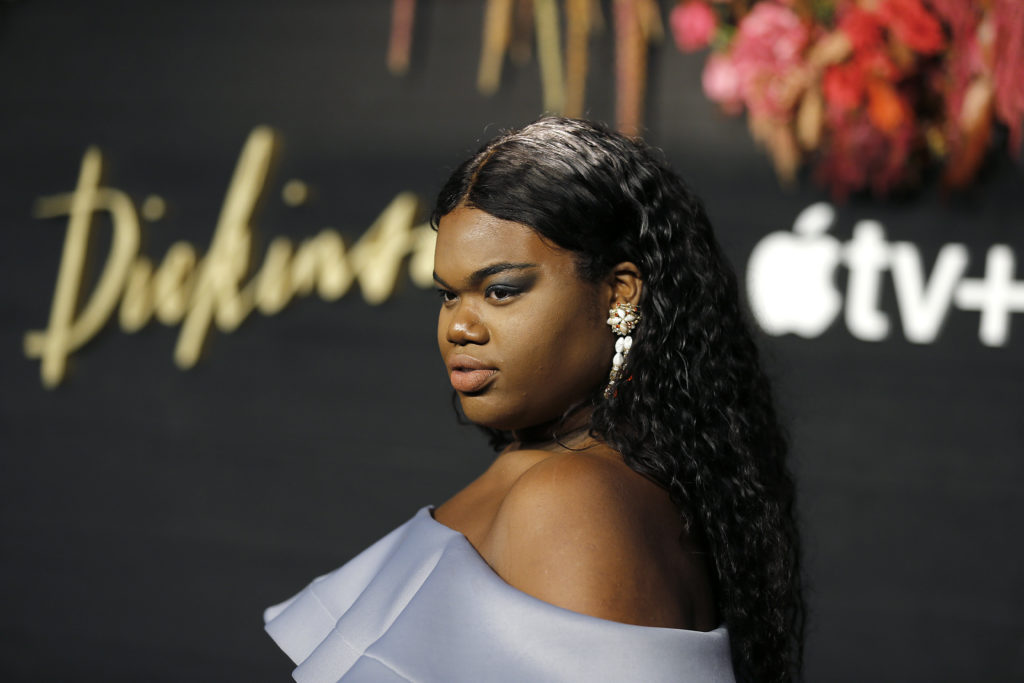Meet Jari Jones, the Black trans plus-sized Calvin Klein model who’s taken over New York – and the internet
Popping a bottle of champagne, a Black trans plus-sized woman looked up at a billboard on Lafayette Street, in New York’s lower Manhattan, to see herself.
Model Jari Jones was surrounded by her friends and she craned her neck high to see the Calvin Klein billboard. Her friends carried signs bearing “Black Lives Matter”, cheering on the face of the fashion brand’s LGBT+ Pride campaign, while her mother on a FaceTime call gushed.
Jones was one of eight queer models who took part in the #ProudInMyCalvins campaign. “It has been such an honour and pleasure to sit in my most authentic self and present imagery of a body that far too often has been demonised, harassed, made to feel ugly and unworthy and even killed,” she wrote in a moving Instagram post.
Jari Jones: ‘Never have I seen a Black trans woman put on such a public platform to be celebrated’.
The campaign also included 13 Reasons Whyactor Tommy Dorfman, artist Gia Woods, trans activist Chella Man, drag queen and singer Pabllo Vittar.
Seeing herself on a billboard, splashing New York’s cavernous skyline, was, to say the least, “overwhelming”, she told Yahoo Life.
“A lot of reflection and history,” she said of the experience.
“Never have I seen a Black trans woman put on such a public platform to be celebrated, and it was overwhelming, like an out-of-body experience.
“It was huge for me. Flooding with so many emotions of my own history of trying to break into the fashion industry, and all the ‘nos’ and ‘you can’ts’ and the ‘you’ll nevers’ all kind of dissipated in that moment.
“It was really, really empowering.”
A meme that radiated across Twitter after the billboard’s unveiling showed the stark evolution of Calvin Klein, from a catalogue of lithely slim white people to representing the kalcedscopic diversity of humanity.
It comes after non-binary Pose star Indya Moore fronted the brand’s 2019 Pride campaign.
But for Jones, 29, as much as the campaign will no doubt be a focal point of her portfolio and résumé for years to come, it’s what her photographs will mean to the countless who see them, whether gliding past in taxis or on a stroll to a bodega.
“It’s taken me a long time to take back that word [‘fat’],” she said. “For so long I was a plus-sized kid, a fat kid, and everybody always told me I was fat.
“If you’re fat you won’t be able to get jobs, if you’re fat you won’t be able to find love,” adding that, after discovering the city’s plus-size community, “how they were owning it,” she was motivated to work through “my own fatphobia.”
That is why her wording of her tweet announcing the campaign – “On Juneteenth, a fat Black trans woman looks over New York” – was important to her.
“It was important for me to put ‘fat’ up there,” she said, “so people know a fat body is worthy of celebration, it’s worthy of love, it’s worthy of respect.
“All those intersections, of being fat, of being trans, of being Black, it needs to be seen and named directly. I didn’t want to sugarcoat anything.”
Calvin Klein Pride campaign is a ‘symbol of hope’, says model.
Jones’ campaign was unveiled on Juneteenth, an annual holiday commemorating the end of slavery in the US. The day constellated around the death of George Floyd under the knee of a white police officer and the killings of two Black trans women, Dominique Fells and Riah Milton, shortly after a Black trans man, Tony McDade, was killed by the police.
And, for as much as LGBT+ activists have secured a roster of rights in recent years, Black trans women are killed with such harrowing frequency that the American Medical Association has declared it an epidemic.


Indeed, Black trans lives, Jones voiced. “I think it’s so important to see the rage and fight, but also see imagery of what the possibilities can be — imagery of Black joy, trans joy, because often all we see is the negative imagery.
“We need some kind of blueprint of what we want out of this.”
Ultimately, Jones explained, what the campaign is isn’t just a way to peddle clothing. It is a “a symbol of hope, and also what the future can be”, she said.
“I feel like that humanizes us, and once you’re humanized, people will think twice before killing you or discriminating against you. I think that when people are being killed in the streets, it’s because they don’t see us as human.”





